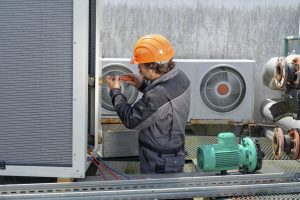
The more you know about how your commercial HVAC system operates, the better off you will be.
The more you know about how your commercial HVAC system operates, the better off you will be. Now that we know more about the basic components of such a system, we can take a better look at the components of the air conditioning unit as well as spend more time discussing how a heat pump is supposed to work.
AC Units
Evaporators: Evaporators make sure that excess condensation is dealt with so that the moisture can’t damage the commercial HVAC system and prevent it from working correctly. Also, the evaporators funnel heat generated by heat pumps that help change liquid coolants back into their gaseous form.
Compressors: Compressors squeeze refrigerant, which means that the pressure exerted on the refrigerant is increased along with making it hotter.
Condensers: Condensers work a bit differently than their counterparts. Warmer air is drawn from outside the building and is fed to the refrigerant, which helps turns the refrigerant into a liquid.
Expansion Devices: Expansion devices, such as specially-purposed valves, also interact with the refrigerant. How the valves do this is by reducing the pressure on the refrigerant. During this state change, the refrigerant is cooled off as well.
Heat Pumps
Despite their name, heat pumps are critical to the cooling of commercial buildings. They are also just one particular type of commercial HVAC system that you could install on your premises, either alone or unison with the other types of systems.
Heat pumps themselves operate by drawing the heat from the air supply or water from the cooling tower. Pipes connect the heat pump to the rest of the building.
Rooftop units are also a common design you’ll see on other commercial buildings around you. These can sometimes be installed directly on the ground, but either way, they rely on ducts to move hot and cold air around the buildings they serve.
Chillers, on the other hand, help maintain a supply of cold water that can be distributed through the building through pipes. The counterpart of the chiller is the heater. Because internal temperatures might not always match outside ones, both heaters and chillers are essential elements of a fully functional commercial HVAC system. Furnaces rely on fuels of some sort to heat up the air, while radiant heaters transfer heat directly to something else. Furnaces can oil, electricity, and gas as their fuel sources. You’ll have to think about the infrastructure you use to manage coolants and ventilation, too.
Crockett Facilities Can Help!
Crockett Facilities Services, Inc. (CFSI) is committed to helping building owners, property managers, engineers, and facility professionals lower their operating expenses through HVAC preventive maintenance. We can develop a cost-effective, customized preventive maintenance plan for your commercial building that will provide you with peace of mind, improved comfort, and energy savings.
To learn more about the importance of HVAC Preventive Maintenance, please contact us at 202.600.2787 or sales@crockett-facilities.com. Our PM contract customers receive priority service with 24/7 emergency service in Maryland, Virginia and Washington, DC.
